
A flag is a symbol. And waving a flag is a way of showing your true colours. However, there is always controversy and uncertainty about what exactly individual flags actually mean. The old Reichskriegsflagge, or Imperial War Flag of the German Reich, has been the centre of intense discussion, most recently in Düsseldorf. There, members of the “Marine Company” (Marine-Kompanie) marched through the city with the controversial flag at a rifle festival. But what about this flag makes it so problematic? Why is it particularly popular with neo-Nazis? And what does Germany’s Criminal Code have to say about the flag?
Black-White-Red: The history of the “Reich war flag”
The origin of the controversial flag long predates the Nazi regime, with which it is now associated by many. The colour schemes of white-black and white-red were used in Prussia, and the coats of arms of numerous Hanseatic cities and other German-speaking regions display these colour combinations. In 1866, the two-colour combinations of previous flag were combined into a flag with a three-colour-sequence: black-white-red. This flag was used by the North German Confederation (Norddeutsches Bund).
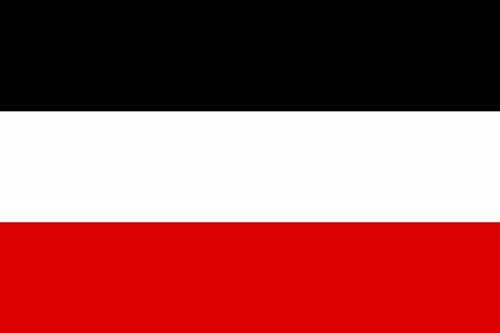
The “Reich flag”: First used in 1867 as the flag of the North German Confederation, used 1892-1919 as the national flag of the German Empire (Kaiserreich) and used 1933-1935 as the flag of the “Third Reich”, alongside the Swastika flag.
One year later, the flag of the War and Merchant Navy (Kriegs- und Handelsmarine) was redesigned to include the black-white-red stripes along with an iron cross and a Prussian eagle. Starting in 1892, this flag flew as the war flag of the German Empire.
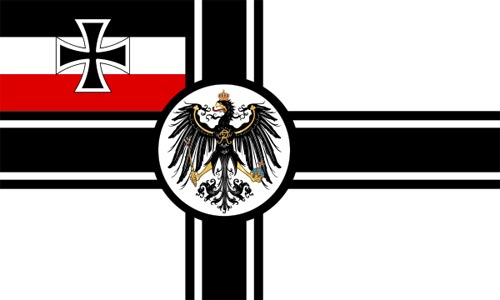
Version of the “Reich war flag” used from 1903-1919
After the fall of the German monarchy in 1918, use of this flag continued for various purposes. The flag remained in use as a naval war flag in the Weimar Republic until December 31, 1921, despite its usage officially being discontinued in 1919, due to the symbols of monarchy on the flag.
The flag of the Weimar Republic was set to be a black-red-gold flag. Right-wing organisations and parties had already adopted the old flag and its black-white-red colour scheme as symbols. A debate over the flag ensued, with representatives of the abolished monarchy criticising the colours of the new flag of the Republic as “black-red-mustard”. They sought to preserve the colours of the old flag. A placard from the German National People’s Party (DNVP), for example, urged voters to “Vote black-white-red!” The new war flag of the Republic ultimately came as a compromise, combining the black-red-gold colour scheme of the Republic with the black-red-white colour scheme of the Empire.
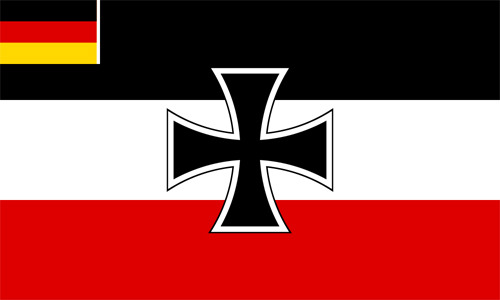
After the Nazis came to power in 1933, they removed the black-red-gold colour scheme of the Republic. Additionally, they slightly altered and shifted the Iron Cross.
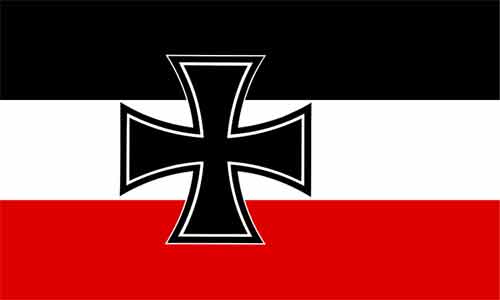
After the death of Reich President Paul von Hindenburg in 1935, the swastika flag was designated as the only valid national flag of the German Reich. Two months later, a similarly styled “Reich war flag” was introduced and flown for the first time at the headquarters of the Wehrmacht in Berlin. Until 1945, the flag flew on all Navy ships, all grounded aircraft and all Wehrmacht buildings. Other uses included covering the coffins of fallen soldiers and draping over lecterns.
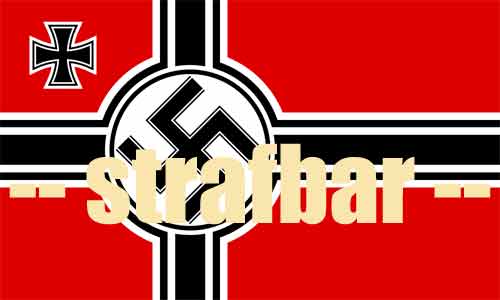
The legal situation
The Reich war flag used by the Nazi regime from 1935 to 1945 is banned in Germany today. Versions of the war flag from other eras, which notably lack the swastika, are legal for public display. The flags may still be seized by the police if public safety and order appear to be endangered. In concrete terms, this means that anyone who sees the flag can call the police, who may then confiscate the flag. However, there are no criminal consequences for wearing or hoisting the flag.
Instead of legal question, a moral question thus arises: What can or should the flag symbolise? What value does it have? Does it not fundamentally stand for jingoism and militarism? And does this flat not inevitably arouse at least associations with the Nazi regime?
Why are “Reich war flags” so popular with neo-Nazis?
Because displaying the Reich war flag of the Nazis is now illegal, right-wing extremists need a replacement flag to wave during their marches. Other versions of the Reich war flag served as legal alternatives for them.
As early as the Weimar Republic, the old (and still legal) Reich war flag was a symbol of right-wing extremist parties and organisations. The paramilitary association “Reichskriegsflagge” (Literally: “Reich war flag”) named their organisation after the flag and used the flag as their identifying symbol. One of the members of the federation was Heinrich Himmler and, from 1923, Adolf Hitler was its political leader. With this context in mind, it is not surprising that neo-Nazis still happily fly the Reich war flag today. The flag is particularly popular as a symbol and identification symbol in the neo-Nazi scene.
Government bodies also see the legal versions of the Reich war flag as an expression of political views. In a directive, the Brandenburg Ministry of the Interior stated in typical bureaucratic prose: “The Reich war flag continues to be a symbol of National Socialist views and/or xenophobia. The use of the flag in public represents a sustained erosion of the requirements for an orderly civic coexistence and is thus a danger to public order.”
Rifle-enthusiasts in Düsseldorf: “A flag of tradition”
Rifle-enthusiasts in Düsseldorf, who marched with a legal version of the Reich war flag, see themselves as “wrongly grouped into the right-wing corner.” The head of the rifle-enthusiast group in the Heerdt district explained in an interview with the “Westdeutsche Zeitung” that, “for us, the flag is a flag of tradition.” He clarified the group wants nothing to do with the far-right groups. The district of Lörick will also not fly the flag in the future, but for a different reason: The flag they currently have is too old and has to be replaced. The new flag should have a more local character.
Also popular with neo-Nazis and also still legal: the “Reich service flag” (Reichsdienstflagge)
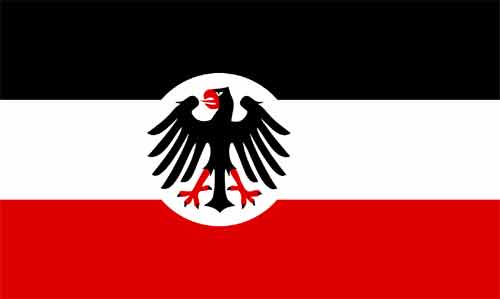 Reichsdienstflagge for Government Bodies in the “Third Reich” from 1933-1935
Reichsdienstflagge for Government Bodies in the “Third Reich” from 1933-1935
Translated by W. F. Thomas.


